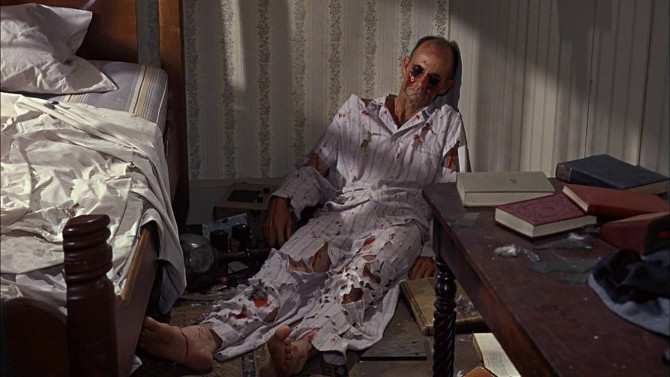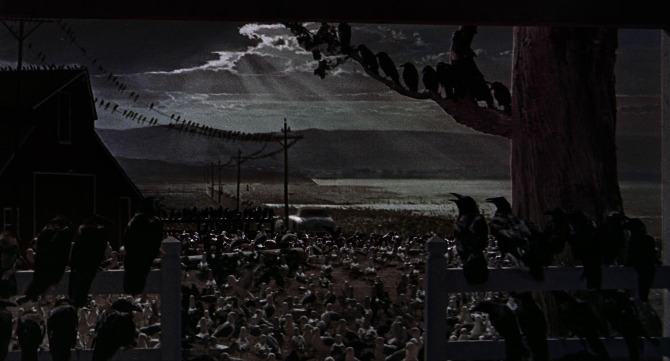 Alfred Hitchcock was always looking for a good challenge – a way to test the boundaries of film, as well as wow his audiences. In 1944, he built a gripping thriller set in the smallest of locations. . . on a Lifeboat. Four years later he challenged himself to shoot murder mystery Rope (again in one location) to look like a single continuous take – due to limitations of the time, it was actually done in ten lengthy takes. In 1954, he tried his hand at 3D. . . though many think of this as a modern day thing, Dial M for Murder fits right within this kitschy novelty’s golden age (1952-54). Then, to get past censors, he reverted to black and white for 1960’s Psycho. Yet one of his biggest challenges came with 1963’s The Birds (a story loosely based upon Daphne du Maurier’s novel of the same name) – not simply because it would be a complicated film to make, but because it was made without any music (actually, it was his longtime musical collaborator Bernard Herrmann who suggested this).
Alfred Hitchcock was always looking for a good challenge – a way to test the boundaries of film, as well as wow his audiences. In 1944, he built a gripping thriller set in the smallest of locations. . . on a Lifeboat. Four years later he challenged himself to shoot murder mystery Rope (again in one location) to look like a single continuous take – due to limitations of the time, it was actually done in ten lengthy takes. In 1954, he tried his hand at 3D. . . though many think of this as a modern day thing, Dial M for Murder fits right within this kitschy novelty’s golden age (1952-54). Then, to get past censors, he reverted to black and white for 1960’s Psycho. Yet one of his biggest challenges came with 1963’s The Birds (a story loosely based upon Daphne du Maurier’s novel of the same name) – not simply because it would be a complicated film to make, but because it was made without any music (actually, it was his longtime musical collaborator Bernard Herrmann who suggested this).
After lengthy years of working under the Motion Picture Production Code (aka, the Hays Code), its grip was finally starting to waver – though it would last until 1968, Hitchcock finally had a little more freedom to amp up the edginess.
Doing to the birds and the sky what Steven Spielberg would do twelve years later for sharks and the water, the narrative follows Melanie Daniels (Tippi Hedren) from her posh life in San Francisco to a small town in Northern California – the picturesque Bodega Bay, where she vehemently tracks down a man, Mitch Brenner (Rod Taylor), who has pranked her in a pet shop. Bringing him love birds for his sister on her birthday, this is some not so subtle symbolism. . . for there is definite chemistry between these two strangers. A romantic game of cat and mouse (or is it. . . cat and bird?) ensues.
Soon after, Daniels is attacked by a seagull while crossing the bay on a boat and avian violence escalates from there – much to the stupefaction of the rural townsfolk. One shocking scene displays this when Lydia (Jessica Tandy), Mitch’s mother, walks into her neighbour’s house and discovers that he has been brutally attacked and killed by the birds. Building upon the shower scene from Psycho, Hitchcock ups the ante. . . a tense, almost delayed form of violent jump scare unexpected for this time in cinema.
Despite some of these perhaps unexpectedly violent scenes, Hitchcock is still able to bring the slow-burning suspenseful moments he is best known for. A prime example of this, which is also one of the most memorable parts of the movie, is when Daniels is sitting outside of a clapboard schoolhouse while the children inside sing an innocent song. Meanwhile, the birds gather slowly behind her in the schoolyard while we watch with fear as their numbers grow; a symbolic depiction of the darkness encroaching upon the unsuspecting innocence of youth.
A technical masterpiece by the Master of Suspense, the film took monumental planning, as Hitchcock, in several instances, had to splice many different shots together to create what, to the naked eye, looks like a single image. Look to the incredible explosion scene (shown from above) and the iconic, open-ended finale. . . in which we see the birds ominously sitting in nearly every inch of the frame, as perfect examples. This latter scene took 32 separately filmed shots to create this stirring final view. In total, three hundred and seventy effects shots can be seen throughout the entire piece. Then there is the scene towards the end when Hedren is attacked by a number of birds upstairs in the home. . . taking a full week to shoot, the birds were hooked to her by long nylon threads so that they couldn’t fly away (she ended up in the hospital due to exhaustion – calling it “the worst week of her life!”). I can only imagine the complexities. . . combining this with the fact that 3,200 birds were trained for the movie, and that much of it was shot on location.
Yet, all of this would be for not without solid characters. Hedren’s Daniels is the prototypical Hitchcockian blonde – beautiful, aloof and mysterious, she draws us in, much like Taylor’s Mitch. . . whose whole life is flipped upside down by this big city dame. Completely hooked, it throws his relationships with the other women in his life – his mother, sister Cathy (Veronica Cartwright), and his former fling, schoolteacher Annie Hayworth (Suzanne Pleshette), out of whack. Yet, it is not just the main cast, but the secondary characters that shine as well. Once you’ve seen the film, you can’t forget the drunken philosopher in the bar (Karl Swenson), or the hysterical mother (Doreen Lang) who thinks Melanie has brought evil upon the quaint little village. It is these smaller roles that add that certain flavour to the piece, a vision of how differently people react in a horrific situation.
With a sense of unending terror, The Birds is a true masterpiece. With these flying creatures taking the upper hand, they flip the script – human beings stuck in their gilded cages, attacked any time they try to go outside. With no score but the sounds of the birds, fascinatingly, you don’t really notice that there isn’t any music – so intense are the real life noises of the little town and its unwanted gulls, ravens, sparrows and the like. A last thing worth mentioning. . . you have to watch the trailer – for Hitchcock was not only The Master of Suspense, but also the master of promotion. So, enjoy this classic piece of mystery/horror, it should make you happy as a lark. . . or crazy as a loon – depending on how you react to it.




